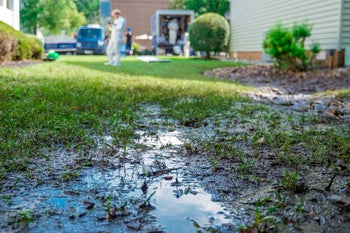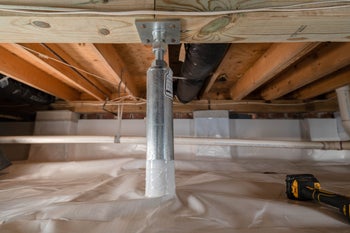The Complete Guide to Crawl Space Support Piers
Table of Contents
1. What Is A Crawl Space Foundation?
2. What Are Crawl Space Support Piers?
3. How Crawl Space Support Piers Can Fail
4. What To Do If The Crawl Space Support Piers Fail
5. Signs Your Home Might Need New Crawl Space Support Piers
6. How To Prevent Problems With Your Crawl Space Foundation
If your home has a crawl space foundation, it has crawl space support piers holding it up. Crawl space support piers are essential to the structural integrity of a crawl space foundation. If anything goes wrong with the piers, you could start to notice problems like bouncy or uneven floors.
This article is a complete guide to crawl space support piers. It explains what crawl space support piers are, how crawl spaces can fail, signs your home might have a crawl space problem, and crawl space repair options.
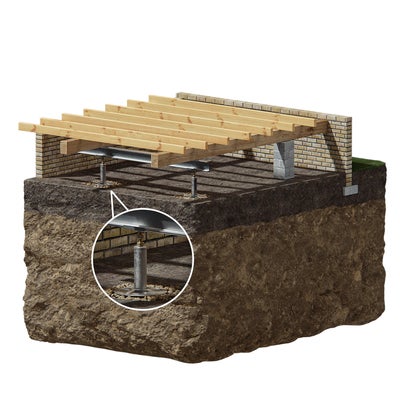
What Is A Crawl Space Foundation?
A crawl space foundation is a type of pier and beam foundation that raises the home anywhere from 1.5 to 3 feet off the ground creating a walled space underneath the house that’s just big enough to crawl around.
Crawl space foundations are less expensive to build than basement foundations and provide easy access to the home’s plumbing and electrical wiring. Because they lift the structure off the ground, crawl space foundations also protect homes against floods.
While the area under the crawl space provides easy access to utilities, it also tends to be damp, making it the perfect “petri dish” for pests and mold. Mold in a crawl space is a serious problem because a certain percentage of air from the crawl space flows up and into your home’s living area via the stack effect. If the air in the crawl space is full of mold spores, the air inside your home will be as well. This can cause allergies and respiratory problems for anyone living in the house.

What Are Crawl Space Support Piers?
Crawl space support piers support the girders (called “beams” in other parts of the U.S.). The floor joists sit on top of the girders, and the floor sits on top of the floor joists. See the accompanying image to illustrate the wooden structures in your home’s crawl space.
As you can see, the crawl space support piers are literally holding up your home. If anything happens to them, it will affect the house’s structural integrity.
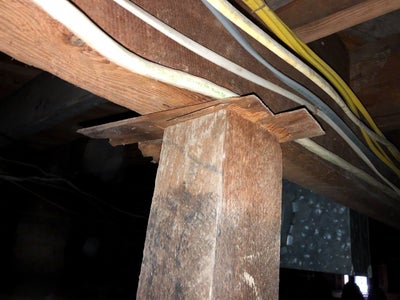
How Crawl Space Support Piers Can Fail
Crawl spaces can fail for various reasons, including:
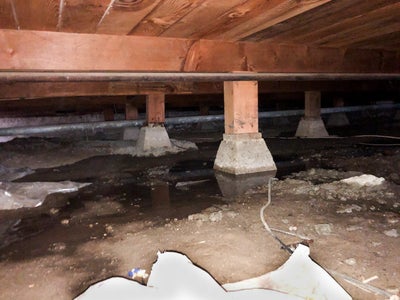
- The crawl space support piers have sunk into the soil – A house weighs a lot. If the soil under the foundation is clay soil, fill, or perhaps the drought season is upon us and the soil is what we call “expansive soil,” the crawl space support piers could gradually settle into the ground. If this happens, you could notice problems like uneven floors, wall cracks, etc. Crawl space foundations in California are susceptible to this problem because of soil issues. For more information, see Crawl Space Beam, Girder and Joist Problems: How to Repair.
- There aren’t enough crawl space support piers under the house – If there aren’t enough crawl space support piers or they’re too far apart, the floor could start to sag between each support pier. You could also see other problems.
- The crawl space support piers have rotted – Crawl spaces are damp, which encourages mold, wood rot, and wood-eating pests like termites. As the crawl space support piers – made of wood – deteriorate, it can lead to structural problems because they’ll have a harder time supporting the house. Crawl spaces with the original screw jacks also experience corrosion and rust over time as the supports begin to fail.
What To Do If The Crawl Space Support Piers Fail
A failing crawl space can often be repaired by simply removing and replacing the crawl space support piers or adding additional piers.
However, if the piers – and the pier blocks – have settled into the soil or rotted, you’ll need to address why that happened and repair it. In other words, you’ll need to solve the root problem before you remove and replace the crawl space support piers. Otherwise, you’ll face the same problem again in a few years.
At Bay Area Underpinning, we offer a solution of removing the wood posts and replacing them with a heavy-duty galvanized crawl space support jack that is adjustable with a wrench if ever you experience sloping again.
Note: Sometimes, a crawl space is supported by steel screw jacks instead of wooden piers. Any deterioration of the screw jacks can compromise the home’s structural integrity. In this case, the deteriorated screw jacks must be removed and replaced.
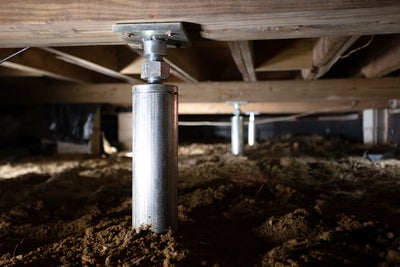
Signs Your Home Might Need New Crawl Space Support Piers
The following are signs of excess moisture in the crawl space, and this could be affecting the crawl space support piers:
- Warped floors
- Floors that feel bouncy when you walk on them
- Mold on baseboards or floor – This means there’s mold in your crawl space.
- Condensation in the home – If warm, humid air enters the crawl space through open vents, it flows up and into your home’s living via the stack effect. It then condenses on cooler surfaces.
- Home smells musty – This strongly indicates a moldy crawl space.
- You’re paying more for heating and cooling – If there’s excess moisture in your crawl space, the air flowing into your home will be humid, and humid air costs more to heat and cool.
- Pests – Damp crawl spaces attract pests, and some of them will eventually make their way into your home’s living area.

How To Prevent Problems With Your Crawl Space Foundation
Although there are a few exceptions, most foundation problems are caused by water. When there’s too much (usually the problem) or too little moisture in the soil around a foundation, you will have trouble. So, the best way to prevent foundation trouble is to control groundwater around the foundation. Here are some ways to do that:
Install a Drain Tile System
A drain tile system is, by far, the best way to prevent hydrostatic pressure from building up in the soil around the foundation. Hydrostatic pressure builds up when there’s excess moisture in the soil. If the pressure isn’t relieved via drainage, it will exert force against the foundation walls. Hydrostatic pressure is strong enough to push water through invisible cracks in the foundation. It can even cause the wall to bow inward and crack. In other words, when there’s too much water in the soil around the foundation, it can eventually cost you thousands of dollars in repairs.
A drain tile system prevents excess water from building up in the soil by channeling it into a perforated drainage pipe and, from there, to a sump pit. Once the sump pit is full of water, a sump pump kicks in and releases the water away from the foundation.
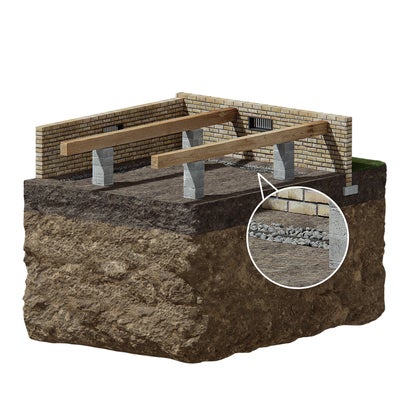
Installing a drain tile system isn’t the least expensive waterproofing option, but it’s the most effective. However, other – less costly – options will also help you control groundwater around the foundation. These include:
- Cleaning your gutters regularly – You don’t want clogged gutters allowing water to spill over the side of the house and into the soil around the foundation.
- Installing downspout extensions – These will carry water away from the foundation before releasing it. Downspouts that are too short will release water next to the foundation, where you don’t want it.
- Installing an underground downspout – Water from the gutter flows into the underground downspout and toward a bubbler pot around 10 feet from the foundation. When the bubbler pot is empty, it’s virtually invisible. However, when it fills with water, it pops up and ejects it away from the foundation.
- Keeping flowers, shrubs, and trees away from the foundation – You don’t want any reason to pour water into the soil near the foundation.
- Regrading your yard so that it slopes away from the foundation – If the yard slopes toward your home, water will drain toward the foundation. This is what you don’t want.
For more information, see The Link Between Foundation Damage And Excess Soil Moisture.
If you suspect problems with the crawl space support piers under your home, don’t hesitate to contact us to schedule a free inspection. We’ll evaluate your home and recommend the best repairs suited for your home’s unique situation.
More Resources
Publish Date:
Last Modified Date:

Our Locations
2333 Courage Dr. Suite C
Fairfield, CA 94533
1161 N Fair Oaks Ave
Sunnyvale, CA 94089

